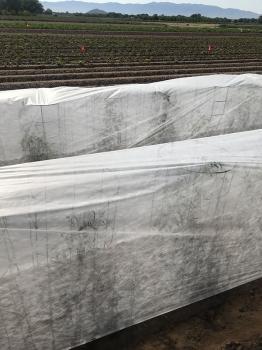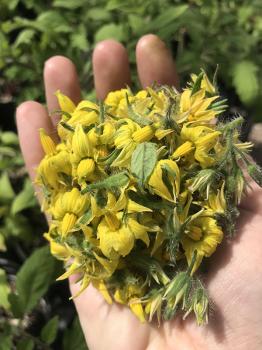June 1, 2019
Undercover Tomatoes
Question:
I suspect that curly top virus caused half of my tomatoes to wilt and die last year before July, so this year I’ve covered each cage with shade cloth to keep the beet leafhopper out. If wrapping each plant keeps insects out, how do the flowers get pollinated?
- Mary T., Belen, NM
Answer:
Covering tomato plants with shade cloth for most of the growing season (especially early on) is a great way to reduce their exposure to the beet leafhopper (Circulifer tenellus), a tiny, jumping insect that is known to transmit curly top virus (also known as beet curly top virus).

Beet curly top virus is known to infect several crops, including (no surprise) beets, tomatoes, peppers, beans, potatoes, spinach, cucurbits (cucumbers, squash, melons, and the like), many ornamentals, and weeds such as Russian thistle (tumbleweed) and mustard (e.g., London rocket). Depending on the host species, infection by this virus causes a range of symptoms, from yellowing and stunted growth to rolling leaves and demise.
Beet leafhoppers are reported to be deterred by shade, so depending on your garden layout and how many plants you have, you can wrap the tomato cages with shade cloth or build a shade structure. Other potential benefits of covering tomato plants are reducing heat stress and conserving water.
Tomato flowers are perfect. That’s not a judgment call on my part—“perfect” is a botanical term used for flowers that house both male and female reproductive structures. Tomato flowers are capable of self-pollination as well as cross-pollination, but because the anthers (male organs that contain pollen) are arranged in a cluster surrounding the stigma (female flower structure that receives the pollen during pollination), the likelihood of a flower being self-pollinated is very high. Therefore, your plants can be entirely covered during flowering without worrying about low tomato yields.
At the NMSU Los Lunas Agricultural Science Center, we’re gearing up for year two of a tomato rooting study. Last October, you may recall, I put the “ag” in “brag” when I boasted about harvesting over 5,000 lb of tomatoes from those research plots. By the first frost, average tomato yield per plant was 35 lb. Those babies were covered with a lightweight cloth row cover with 85% light transmission (commonly sold as frost protection) from the day they were planted, and before that were grown under a shaded structure.

If you’ve had problems with curly top virus in years past, or if you suspect you have, consider covering your plants, particularly during the early season when plants tend to be more vulnerable to developing severe disease symptoms, like death.
If you suspect your plants have been affected, you can send leaf samples to the NMSU Plant Diagnostic Clinic for diagnoses and recommendations. This service is free when samples are submitted through your NMSU Cooperative Extension County Office.
In previous years, the Plant Diagnostic Clinic has received samples that were confirmed cases of beet curly top virus infection in the counties of Doña Ana, Sandoval, Bernalillo, Valencia, Otero, San Juan, Roosevelt, Torrance, and others. Although no samples have been reported with curly top virus so far this year, it’s possible that more plants will be affected this year than usual. For years, NMSU Plant Virology Professor Dr. Rebecca Creamer has been trapping beet leafhoppers around the margins of chile fields in the Mesilla Valley to keep track of spring population levels and warn growers about potential disease exposure. This year’s leafhopper numbers are the highest since 2001. For more details about Dr. Creamer’s findings and tips for curly top identification and control, visit Desert Blooms and search “curly.”
Check out the NMSU Extension Circular 457: Home Vegetable Gardening in New Mexico for more veggie info. Access the several hundred other NMSU Extension Publications.
Marisa Y. Thompson, PhD, is the Extension Horticulture Specialist, in the Department of Extension Plant Sciences at the New Mexico State University Los Lunas Agricultural Science Center, email: desertblooms@nmsu.edu, office: 505-865-7340, ext. 113.
Links:
For more gardening information, visit the NMSU Extension Horticulture page at Desert Blooms and the NMSU Horticulture Publications page.
Send gardening questions to Southwest Yard and Garden - Attn: Dr. Marisa Thompson at desertblooms@nmsu.edu, or at the Desert Blooms Facebook page.
Please copy your County Extension Agent and indicate your county of residence when you submit your question!